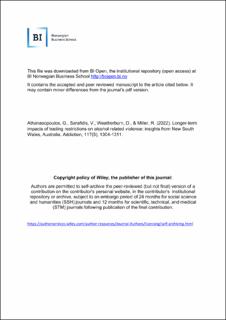| dc.description.abstract | Background and Aims:In February 2014, the government of New South Wales (NSW),Australia, introduced new restrictions (known as the‘lockout laws’) on the sale of alco-hol in licensed premises in two of Sydney’s most prominent entertainment districts,Kings Cross (KX) and the central business district (CBD). This study aimed to determine:(i) whether the introduction of the lockout laws was the point at which the time patternof the assault series in the KX and CBD entertainment precincts changed; (ii) whetherthe apparent reduction in assault in these precincts persists when we control for com-mon variations in assault across the entire state of NSW; (iii) whether the reduction inassault in the KX and CBD entertainment precincts resulted in a displacement of theassault problem into other areas; and (iv) whether there is a net reduction in assault aftertaking any spill-over or displacement effects into account.Design:Structural break analysis was used to determine the date at which the time pat-tern of assaults changed. Interrupted time series analysis with a rest-of-NSW comparatorwas used to assess the change in assault.Setting, cases and measurements:The monthly totals of incidents of non-domesticassaults reported to the NSW Police between January 2009 and March 2019 (n= 123).Findings:The structural break in assaults occurred in January 2014 rather than inFebruary 2014, when the lockout laws were introduced. The reduction in assault persistseven when we control for common influences across NSW as a whole. In particular, fromJanuary 2014 onwards, assaults fell immediately by 22% (a downward step) in KX (90%confidence interval [CI] = 15–28) and by 33% in the CBD (90% CI = 19–47). Assaultscontinued declining in KX (trend-break coefficient =−0.094, 90% CI =−0.192 to 0.005).The reduction in assault in the KX and CBD precincts is associated with a rise in assaultin areas surrounding these precincts. The net effect, nonetheless, remains a lower levelof assault. In particular, we estimate that the net reduction over the three areas com-bined was 1670 assaults (i.e. 27 per month).Conclusion:Some of the initial reduction in assault in KX and the CBD of Sydney, Australia,previously attributed to the February 2014 introduction of lockout laws may have been aresponse to publicity surrounding recent deaths connected with alcohol-related violence. | en_US |
